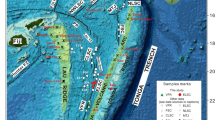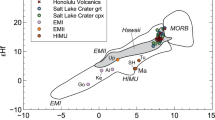Abstract
The two parallel chains of Hawaiian volcanoes (‘Loa’ and ‘Kea’) are known to have statistically different but overlapping radiogenic isotope characteristics. This has been explained by a model of a concentrically zoned mantle plume, where the Kea chain preferentially samples a more peripheral portion of the plume. Using high-precision lead isotope data for both centrally and peripherally located volcanoes, we show here that the two trends have very little compositional overlap and instead reveal bilateral, non-concentric plume zones, probably derived from the plume source in the mantle. On a smaller scale, along the Kea chain, there are isotopic differences between the youngest lavas from the Mauna Kea and Kilauea volcanoes, but the 550-thousand-year-old Mauna Kea lavas are isotopically identical to Kilauea lavas, consistent with Mauna Kea's position relative to the plume, which was then similar to that of present-day Kilauea. We therefore conclude that narrow (less than 50 kilometres wide) compositional streaks, as well as the larger-scale bilateral zonation, are vertically continuous over tens to hundreds of kilometres within the plume.
This is a preview of subscription content, access via your institution
Access options
Subscribe to this journal
Receive 51 print issues and online access
$199.00 per year
only $3.90 per issue
Buy this article
- Purchase on Springer Link
- Instant access to full article PDF
Prices may be subject to local taxes which are calculated during checkout



Similar content being viewed by others
References
Dana, J. D. Geology, United States Exploring Expedition, during the years 1838–1839, 1840, 1841, 1842 Vol 10 (C. Sherman, Philadelphia, 1849)
Jackson, E. D., Shaw, H. R. & Bargar, K. E. Calculated geochronology and stress field orientations along the Hawaiian chain. Earth Planet. Sci. Lett. 26, 145–155 (1975)
Dalrymple, G. B., Silver, E. A. & Jackson, E. D. Origin of the Hawaiian islands. Am. Sci. 61, 294–308 (1973)
Stille, P., Unruh, D. M. & Tatsumoto, M. Pb, Sr, Nd and Hf isotopic evidence of multiple sources for Oahu, Hawaii basalts. Nature 304, 25–29 (1983)
Tatsumoto, M. Isotopic composition of lead in oceanic basalt and its implication to mantle evolution. Earth Planet. Sci. Lett. 38, 63–87 (1978)
Hauri, E., Lassiter, J. C. & DePaolo, D. J. Osmium isotope systematics of drilled lavas from Mauna Loa, Hawaii. J. Geophys. Res. 101, 11793–11806 (1996)
Kurz, M. D., Kenna, T. C., Lassiter, J. C. & DePaolo, D. J. Helium isotopic evolution of Mauna Kea Volcano: first results from the 1-km drill core. J. Geophys. Res. 101, 11781–11791 (1996)
Lassiter, J. C., DePaolo, D. J. & Tatsumoto, M. Isotopic evolution of Mauna Kea volcano: Results from the initial phase of the Hawaiian Scientific Drilling Project. J. Geophys. Res. 101, 11769–11780 (1996)
DePaolo, D. J. High-frequency isotopic variations in the Mauna Kea tholeiitic basalt sequence: melt zone dispersivity and chromatography. J. Geophys. Res. 101, 11855–11864 (1996)
Sharp, W. A. & Renne, P. R. 40Ar/39Ar dating of core recovered by the Hawaii Scientific Drilling Project (phase 2), Hilo, Hawaii. Geochem. Geophys. Geosyst. (in the press)
Eisele, J., Abouchami, W., Galer, S. J. G. & Hofmann, A. W. The 320 kyr Pb isotope evolution of Mauna Kea lavas recorded in the HSDP-2 drill core. Geochem. Geophys. Geosyst. 4, doi:10.1029/2002GC000339 (2003)
Blichert-Toft, J., Weis, D., Maerschalk, C., Agranier, A. & Albarede, F. Hawaiian hot spot dynamics as inferred from the Hf and Pb isotope evolution of Mauna Kea volcano. Geochem. Geophys. Geosyst. 4, 8704, doi:10.1029/2002GC000340 (2003)
Farnetani, C. G., Legras, B. & Tackley, P. J. Mixing and deformation in mantle plumes. Earth Planet. Sci. Lett. 196, 1–15 (2002)
Galer, S. J. G. Optimal double and triple spiking for high precision lead isotopic measurement. Chem. Geol. 157, 255–274 (1999)
Abouchami, W., Galer, S. J. G. & Hofmann, A. W. High precision lead isotope systematics of lavas from the Hawaiian Scientific Drilling Project. Chem. Geol. 169, 187–209 (2000)
Stolper, E. M., Sherman, S., Garcia, M. O., Baker, M. & Seaman, C. Glasses in the submarine section of the HSDP-2 drill core, Hilo, Hawaii. Geochem. Geophys. Geosyst. 5, doi:10.1029/2003GC000553 (2004)
Kurz, M. D., Curtice, J., Lott, D. E. & Solow, A. Rapid helium isotopic variability in Mauna Kea shield lavas from the Hawaiian Scientific Drilling Project. Geochem. Geophys. Geosyst. 5, doi:10.1029/2002GC000439 (2004)
Bryce, J. G. & DePaolo, D. J. Sr and Nd variations in Mauna Kea lavas: preliminary results from analyses from the 1999 Hawaiian Scientific Drilling Project. Eos Trans. AGU 81, abstr. V12C–01 (2000)
Galer, S. J. G. & O'Nions, R. K. Residence time of thorium, uranium and lead in the mantle with implications for mantle convection. Nature 316, 778–782 (1985)
Garcia, M. O., Muenow, D. W. & Aggrey, K. E. Major element, volatile, and stable isotope geochemistry of Hawaiian submarine tholeiitic glasses. J. Geophys. Res. 94, 10525–10538 (1989)
Yang, H. J., Frey, F. A., Garcia, M. O. & Clague, D. A. Submarine lavas from Mauna Kea Volcano, Hawaii: implications for Hawaiian shield stage processes. J. Geophys. Res. 99, 15577–15594 (1994)
Easton, R. M. in Volcanism in Hawaii (eds Decker, R. W., Wright, T. L. & Stauffer, P. H.) 243–260 (US Geological Survey Prof. Pap. 1350, Boulder, Colorado, 1987)
Quane, S. L., Garcia, M. O., Guillou, H. & Hulsebosch, T. P. Magmatic history of the East Rift Zone of Kilauea Volcano, Hawaii based on drill core from SOH 1. J. Volcanol. Geotherm. Res. 102, 319–338 (2000)
Lipman, P. W., Sisson, T. W., Ui, T., Naka, J. & Smith, J. R. in Hawaiian Volcanoes: Deep Underwater Perspectives (eds Takahashi, E., Lipman, P. W., Garcia, M. O., Naka, J. & Aramaki, S.) 161–191 (AGU, Washington, DC, 2002)
DePaolo, D. J., Bryce, J. G., Dodson, A., Shuster, D. L. & Mack Kennedy, B. Isotopic evolution of Mauna Loa and the chemical structure of the Hawaiian plume. Geochem. Geophys. Geosyst. 2, doi:10.1029/2000GC000139 (2001)
Hauri, E. H., Whitehead, J. A. & Hart, S. R. Fluid dynamic and geochemical aspects of entrainment in mantle plumes. J. Geophys. Res. 99, 24275–24300 (1994)
Loper, D. E. & Stacey, F. D. The dynamical and thermal structure of deep mantle plumes. Phys. Earth Planet. Inter. 33, 304–317 (1983)
Olson, P., Schubert, G. & Anderson, C. Structure of axisymmetric mantle plumes. J. Geophys. Res. 98, 6829–6844 (1993)
Schubert, G., Turcotte, D. L. & Olson, P. Mantle Convection in the Earth and Planets (Cambridge Univ. Press, New York, 2001)
Zindler, A. & Hart, S. R. Chemical geodynamics. Annu. Rev. Earth Planet. Sci. 14, 493–571 (1986)
Eisele, J. et al. The role of sediment recycling in EM-1 inferred from Os, Pb, Hf, Nd, Sr isotope and trace element systematics of the Pitcairn hotspot. Earth Planet. Sci. Lett. 196, 197–212 (2002)
Blichert-Toft, J., Albarède, F. & Frey, F. Hf isotopic evidence for pelagic sediments in the source of Hawaiian basalts. Science 285, 879–882 (1999)
Tanaka, R. & Nakamura, E. in Hawaiian Volcanoes: Deep Underwater Perspectives (eds Takahashi, E., Lipman, P. W., Garcia, M. O., Naka, J. & Aramaki, S.) 311–332 (AGU, Washington, DC, 2002)
Fekiacova, Z. & Abouchami, W. Pb isotopic evolution of Koolau volcano (Oahu, Hawaii). Eos Trans. AGU 84, V32A-0991 (2003)
Clague, D. A. & Dalrymple, G. B. in The Eastern Pacific Ocean and Hawaii (eds Winterer, E. L., Hussong, D. M. & Decker, R. W.) 188–217 (Geological Society of America, Boulder, Colorado, 1989)
Wessel, P. & Kroenke, L. A geometric technique for relocating hotspots and refining absolute plate motions. Nature 387, 365–369 (1997)
Hieronymus, C. F. & Bercovici, D. Discrete alternating hotspot islands formed by interaction of magma transport and lithospheric flexure. Nature 397, 604–607 (1999)
ten Brink, U. Volcano spacing and plate rigidity. Geology 19, 397–400 (1991)
Hauri, E. H. Major-element variability in the Hawaiian mantle plume. Nature 382, 415–419 (1996)
Kellog, L. H., Hager, B. H. & van der Hilst, R. V. Compositional stratification in the deep mantle. Science 283, 1881–1884 (1999)
Ribe, N. M. & Christensen, U. R. The dynamical origin of Hawaiian volcanism. Earth Planet. Sci. Lett. 171, 517–531 (1999)
Farnetani, C. & Samuel, H. Dynamics of thermochemical plumes. Eos Trans. AGU 85, V44B–03 (2004)
Kerr, R. C. & Meriaux, C. Structure and dynamics of sheared mantle plumes. Geochem. Geophys. Geosyst. 5, doi:10.1029/2004GC000749 (2004)
Acknowledgements
We thank M. Garcia, H. West, and the HSDP team for providing samples, and J. Bryce for providing updated Nd isotope data for HSDP-2. Comments from M. Garcia and E. Takahashi on Nuuanu landslides stratigraphy, and reviews from E. Hauri and B. Hanan were appreciated.
Author information
Authors and Affiliations
Corresponding author
Ethics declarations
Competing interests
The authors declare that they have no competing financial interests.
Supplementary information
Supplementary Table S1
Triple spike Pb isotope data on Hawaiian lavas. (XLS 53 kb)
Supplementary Table S2
Regression parameters for Hawaiian Pb isotope arrays. (XLS 17 kb)
Supplementary Table S3
F-test statistics of the Loa and Kea regression trends. (DOC 39 kb)
Supplementary Figure S1
Triple spike Pb isotope data of Hawaiian shield stage lavas plotted in Pb isotope space. (PDF 183 kb)
Supplementary Figure S2
Schematic cartoon of the Hawaiian plume structure based on triple spike Pb isotope data in Hawaiian lavas. (PDF 415 kb)
Rights and permissions
About this article
Cite this article
Abouchami, W., Hofmann, A., Galer, S. et al. Lead isotopes reveal bilateral asymmetry and vertical continuity in the Hawaiian mantle plume. Nature 434, 851–856 (2005). https://doi.org/10.1038/nature03402
Received:
Accepted:
Issue Date:
DOI: https://doi.org/10.1038/nature03402
This article is cited by
-
Hawaiian postshield volcanism over the past 55 million years
Contributions to Mineralogy and Petrology (2024)
-
Earth’s mantle composition revealed by mantle plumes
Nature Reviews Earth & Environment (2023)
-
Evidence for compositionally distinct upper mantle plumelets since the early history of the Tristan-Gough hotspot
Nature Communications (2023)
-
40Ar/39Ar geochronology of basalts from Kaua‘i, Hawai‘i: implications for shield-stage evolution of Hawaiian volcanoes
Bulletin of Volcanology (2023)
-
Mantle plumes and their role in Earth processes
Nature Reviews Earth & Environment (2021)
Comments
By submitting a comment you agree to abide by our Terms and Community Guidelines. If you find something abusive or that does not comply with our terms or guidelines please flag it as inappropriate.



